To the editor: The recent article by Jeff Merrill on bilge maintenance (“Tasteless bilge water,” March/April 2018) was well written and provided some excellent details and suggestions.
My take is that if your bilge is not bone dry during normal operations, then here is what you need to do:
1. Identify all possible “normal” minor drips — engine shaft seal, rudder shaft seal, air conditioning condensate, refrigerator box or ice box drain, large dorades — that might allow water into the bilge.
2. Build a catchment system for all these normal drips and lead them to one or more small “bilge boxes” with a dedicated small float switch and pump. This system should normally maintain a dry bilge, which does not smell, does not risk oils being pumped overboard, requires little power consumption, etc. It is not expensive to install a small box, sensor and pump.
3. Clean the bilge thoroughly of all residue, dirt, oil film, etc., and dry it with towels or a fan. The bilge should always be dry, smell clean and have a really big bilge pump and sensor designed to eliminate any major leakage. The large pump should always be ready to operate, and the float switch pristinely clean.
4. If even the slightest drop or teaspoon of water is seen during a bilge inspection, you know you have a problem somewhere and you need to find it and fix it.
5. If or when our dry deep bilge alarm goes off, I know I have a major problem since that bilge should always be bone dry and clean. That has only happened once in the last 12 years, and it was a very high adrenaline moment.
6. No well-designed boat should be without a water catchment system to handle the routine minor drips, completely separate from the primary bilge pump systems.
—Marilyn Kinsey sails a Bristol 35.5C named Adena.
Jeff Merrill responds: Thank you very much for your suggestions. My article ran much longer than I originally intended and I’m actually outlining a second related piece on bilge pumps and was going to include “water boxes” — I’ve seen them used for shower sumps and air conditioning condensates.
It is difficult to write an all-encompassing article that applies to every situation, given the many different hull shapes and bilge arrangements.

